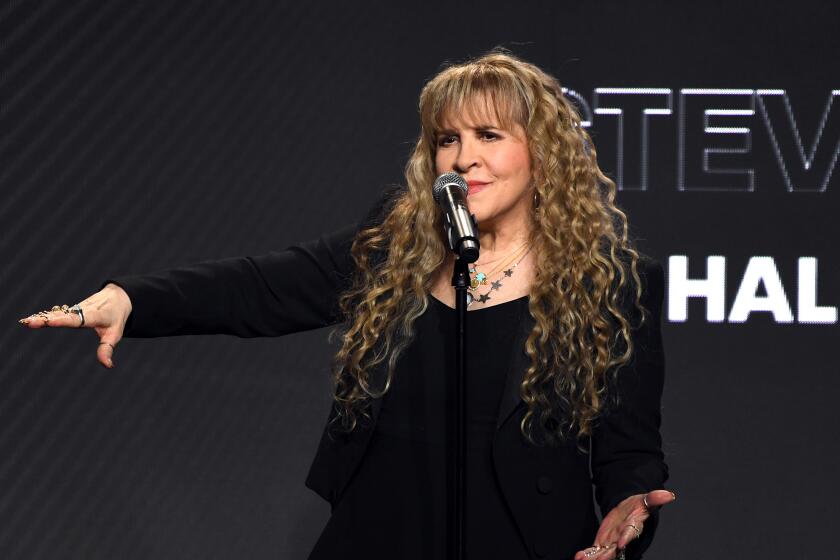Bird Brouhaha, or the Grave Situation of Charlie Parker
- Share via
The turbulence surrounding Charlie Parker’s brief, star-crossed life barely subsided when he died in New York City on March 12, 1955. Among other things, rumors have circulated for decades that the reported cause of death--lobar pneumonia--was incorrect. Despite the fact that an autopsy was conducted, stories suggesting that he was shot, that he was injured in a fight with another musician, that there was a cover-up, have persisted.
And it didn’t stop there. Parker was interred in Kansas City, Mo., despite the assertion by his then common-law wife, Chan Parker, that he had asked her not to permit anyone to bury him in his hometown. Compounding the situation, his initial gravestone gave the wrong date of birth, and a new gravestone (unveiled in 1994) includes a carving of a tenor saxophone rather than Parker’s chosen instrument, the alto.
“That may be an inconsequential detail to many,” writes Mike Metheny, editor of Kansas City’s JAM magazine, “but if somebody carved a banjo onto Elvis Presley’s tombstone, you can bet there would be an uproar about that.”
The Parker drama was revived again this year, when a plan was unveiled to move the legendary saxophonist’s remains from the Lincoln Cemetery--which now has come on hard times--to a specially planned location (which already displays one of Parker’s saxophones) at 18th and Vine, one of Kansas City’s historic jazz locations.
At the moment, there is no easy solution, with much of Kansas City’s jazz community taking sides. The Charlie Parker Memorial Foundation, which maintains the grave site, is adamantly opposed to the exhumation. Others, including Metheny, see it as an opportunity to create a dignified final resting place for Parker.
In an unrelated but parallel development, Kansas City engineer Bill Alburty is advocating the modification of a local television tower to create the image of a 900-foot-high saxophone as a tribute to the city’s identify as a jazz mecca. Maybe the Parker grave plannersand the giant saxophone advocates should get together in a common cause.
Cool Yule
Christmas songs and Christmas carols have always had a strong appeal to jazz players, in part because many possess unusually attractive harmonies or brightly buoyant rhythms. Here’s a quick rundown on some of the more appealing new releases:
“Christmas With the George Shearing Quintet” (Telarc). Gently swinging renderings of familiar (“White Christmas,” “The Christmas Song”) and less familiar (Claude Thornhill’s “Snowfall” and the French carol “Ding Dong! Merrily on High”) tunes by a quintet sounding very much like Shearing’s famous vibes-and-guitar groups of the ‘40s and ‘50s.
“Etta James: 12 Songs of Christmas” (Private Music). The veteran singer works her blues and gospel-tinged magic on another set of familiar numbers--including a grooving romp through “Merry Christmas, Baby.”
“A Jazz Christmas” (Windham Hill). There’s plenty here to please smooth-jazz fans, as well as some more edgy work from the Braxton Brothers and Larry Coryell (doing a solo reconstruction of “Deck the Halls”).
“Justin Time for Christmas Two” (Justin Time). The Canadian company’s second jazz Christmas outing, with a solidly mainstream orientation. There are engaging performances from pianists Paul Bley and Oliver Jones, and a romping ride through “Jingle Bells” with singer-pianist Diana Krall.
“Big Band Christmas” (Concord). Rob McConnell and the Boss Brass take a characteristically lush look at the standard Christmas repertoire, with a heavy emphasis upon the rich timbral potential in an ensemble rich with woodwinds and French horns.
“Christmas Caravan” (Mammoth). Squirrel Nut Zippers, one of the hot new, young swing-styled ensembles, takes a crack at Christmas-style tunes, most of them originals. The songs are all over the place, ranging from country-style angst to hot jazz, with titles such as “Carolina Christmas” and “A Johnny Ace Christmas.”
Swingin’ In the New Year
Jazz fans once again have an excellent alternative to television’s New Year’s Eve rock celebrations. National Public Radio, available locally via KLON-FM (88.1), ispresenting six hours of live jazz from four cities. The program includes three countdowns to midnight in three time zones.
The program, sponsored by Courvoisier Cognac, kicks off at 7 p.m. with a concert in Toronto featuring soprano saxophonist Jane Bunnett, performing with Canadian and Cuban musicians. The New Year arrives in New York City at the close of the 8 o’clock segment, which showcases the Spirituals to Swing all-star band performing at Manhattan’s Iridium club. The group’s lineup includes pianist Cyrus Chestnut, guitarist Mark Whitfield, saxophonists Craig Handy and Donald Harrison, drummer Carl Allen and bassist Rodney Whitaker, with guest vocalist Vanessa Rubin.
Singer Kurt Elling rings in the New Year in Chicago at the close of the 9 o’clock segment, performing at the Hot House club with the Laurence Hobgood Trio and guest trumpeter Orbert Davis. And the evening climaxes with a Diana Krall set--including superb guitarist Russell Malone--from Yoshi’s in Oakland.
More to Read
The biggest entertainment stories
Get our big stories about Hollywood, film, television, music, arts, culture and more right in your inbox as soon as they publish.
You may occasionally receive promotional content from the Los Angeles Times.










